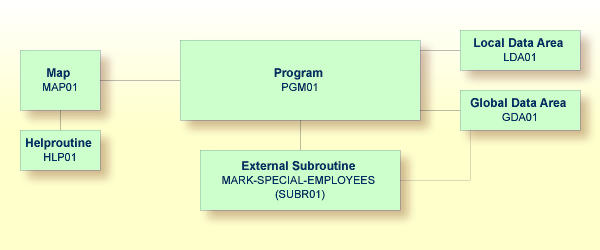Until now, the subroutine MARK-SPECIAL-EMPLOYEES has been
defined within the program using a DEFINE SUBROUTINE statement.
You will now define the subroutine as a separate object external to the
program.
When you have completed the exercises below, your sample application will consist of the following modules:

This document contains the following exercises:
You will now invoke an editor in which you will specify the code for the external subroutine.
The DEFINE SUBROUTINE statement of the external subroutine
is coded in the same way as the inline subroutine in the program.
 To create an external subroutine
To create an external subroutine
In the library workspace, select the library which also contains your program (that is: select the TUTORIAL node).
From the context menu, choose .
An empty editor window appears.
Enter the following:
DEFINE DATA GLOBAL USING GDA01 LOCAL USING LDA01 END-DEFINE * DEFINE SUBROUTINE MARK-SPECIAL-EMPLOYEES MOVE '*' TO #MARK END-SUBROUTINE * END
Stow the subroutine.
The Stow As dialog box appears.
Enter "SUBR01" as the name of the external subroutine and choose the button.
In the library workspace, the new external subroutine is shown in the
Subroutines node. In logical view, the name of the
subroutine is shown as defined in the code:
MARK-SPECIAL-EMPLOYEES. In all other views, the name
SUBR01 is shown.
Close the editor window in which you have entered the external subroutine.
The PERFORM statement invokes both internal and external
subroutines. When an internal subroutine is not found in the program, Natural
automatically tries to perform an external subroutine with the same name. Note
that Natural looks for the name that has been defined in the subroutine code
(that is: the subroutine name), not for the name that you have specified when
saving the subroutine (that is: the Natural object name).
Now that you have defined an external subroutine, you have to remove the inline subroutine (which has the same name as the external subroutine) from your program.
 To use the external subroutine in your program
To use the external subroutine in your program
Return to the program editor.
Remove the following lines:
DEFINE SUBROUTINE MARK-SPECIAL-EMPLOYEES MOVE '*' TO #MARK END-SUBROUTINE
Your program should now look as follows:
DEFINE DATA
GLOBAL USING GDA01
LOCAL USING LDA01
END-DEFINE
*
RP1. REPEAT
*
INPUT USING MAP 'MAP01'
*
IF #NAME-START = '.' THEN
ESCAPE BOTTOM (RP1.)
END-IF
*
IF #NAME-END = ' ' THEN
MOVE #NAME-START TO #NAME-END
END-IF
*
RD1. READ EMPLOYEES-VIEW BY NAME
STARTING FROM #NAME-START
ENDING AT #NAME-END
*
IF LEAVE-DUE >= 20 THEN
PERFORM MARK-SPECIAL-EMPLOYEES
ELSE
RESET #MARK
END-IF
*
DISPLAY NAME 3X DEPT 3X LEAVE-DUE 3X '>=20' #MARK
END-READ
*
IF *COUNTER (RD1.) = 0 THEN
REINPUT 'No employees meet your criteria.'
END-IF
*
END-REPEAT
*
END
Run the program.
Enter "JONES" as the starting name and press ENTER.
The resulting list should still show an asterisk for each employee who has 20 days of leave and more.
Press ESC to close the output window.
Stow the program.
You can now proceed with the next exercises: Subprograms.